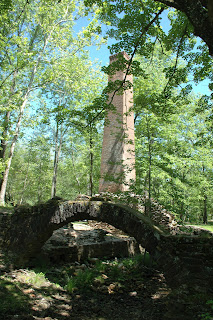These weren't factories in the 20th or 21st century tradition ... they were OLD, befitting the development (or lack thereof) of the Pinelands. What many people don't realize is that while there's very little industry there now, the area was a hotbed of production in the early days of the United States.
 |
| There's iron in that water! |
We've talked a lot about the iron mines of the northern reaches of the state, but very little about the south, where bog iron once drove significant industry in the Pinelands. A partnership of five men got state permission in 1801 to dam the Great Egg Harbor River as a power source for an iron works at Weymouth, and within 50 years, the site was host to one of the region's largest communities. Besides a charcoal-fired furnace and forge, industry on the 85,000 acre site included a gristmill, sawmill, blacksmith and wheelwright. A store and Methodist church were also built, along with housing for workers and a large mansion for the forge's owner.
 For most of its operating history, the iron forge produced mundane items like nails, pipes, stoves and cooking pots, but it contributed to the nation's defense, too. Weymouth supplied shot and bombs to the army for the War of 1812, though it seems not to have done the same during the Civil War. With the development of the coal industry, Pennsylvania forges could produce better quality iron products, essentially leaving New Jersey in the dust.
For most of its operating history, the iron forge produced mundane items like nails, pipes, stoves and cooking pots, but it contributed to the nation's defense, too. Weymouth supplied shot and bombs to the army for the War of 1812, though it seems not to have done the same during the Civil War. With the development of the coal industry, Pennsylvania forges could produce better quality iron products, essentially leaving New Jersey in the dust.Iron processing may have ceased to be an option at that point, but the river continued to power industry at the site. The Atlantic Paper Mill and Weymouth Paper Mill recycled rags, bagging and manila rope to produce paper until wood pulp became more prevalent as the main ingredient for paper products. By 1898, the mills were silent, rendered obsolete by progress.
The property lay unused, buildings decaying and vandalized, until 1966, when the Atlantic County government started buying up the property for inclusion in the park system. Some of the ruins have been fenced in for protection, but you can still reach some of the stabler structures, including the arches that span the largely dry millraces. A cast-brick chimney also stands in stark contrast to the stone foundations of the furnace it once served.
Given the impulses that unfortunately drive some people to destroy history, I have to say it makes sense to surround the Weymouth ruins with a park. Visitors are exposed to a fascinating aspect of South Jersey history as they picnic and canoe through the property, and hopefully that encourages them to learn more. Having people around also tends to deter vandals from acting out.
One resident in particular seemed to be taking extra effort to guard the fenced-in ruins while we were there. Ivan noticed a female Louisiana waterthrush sitting on a branch just above the enclosure, wagging her tail from side to side as if conducting an orchestra. She patiently waited for us to leave, no doubt because she wanted to distract us from her nest. Regardless, it was a nice little surprise, considering we didn't expect much avian activity during the middle of the day.
No comments:
Post a Comment
Note: Only a member of this blog may post a comment.